
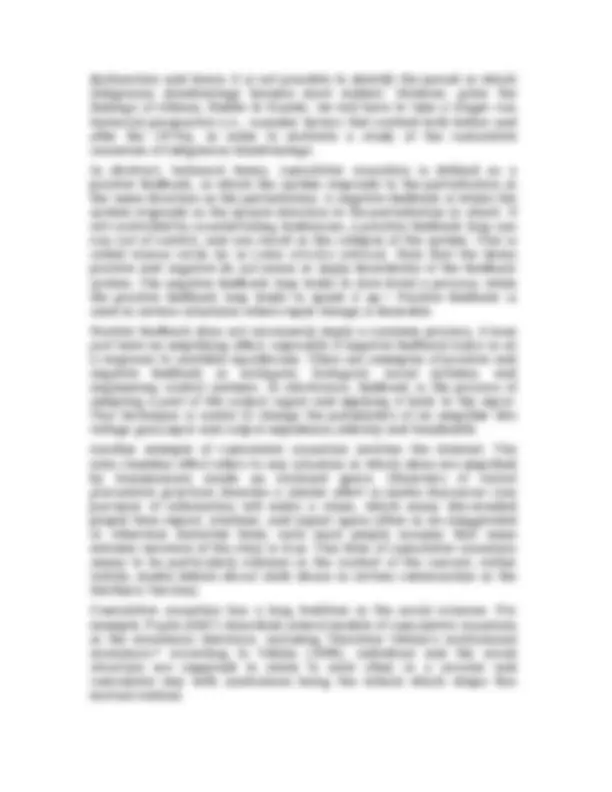
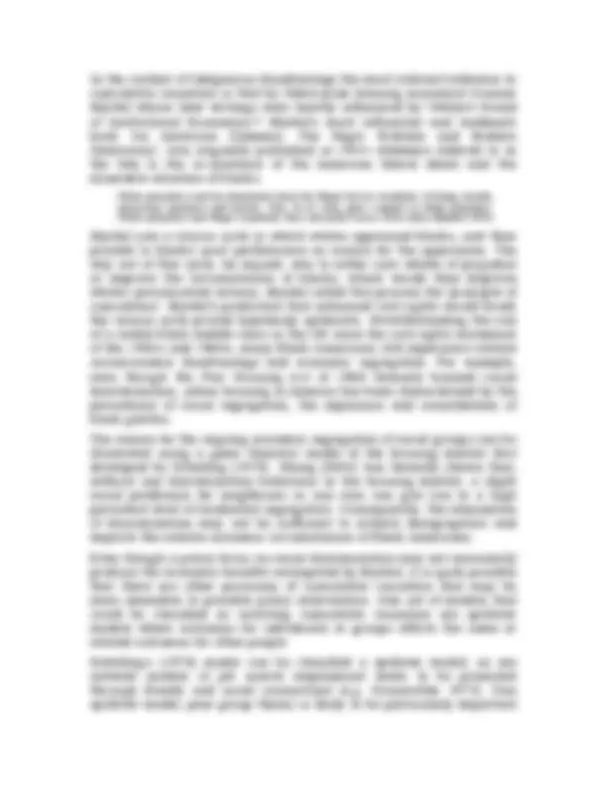
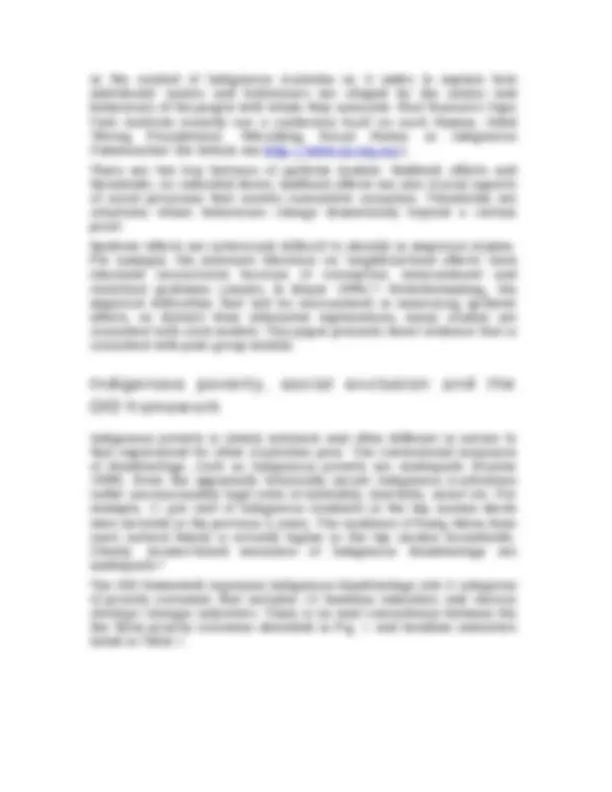
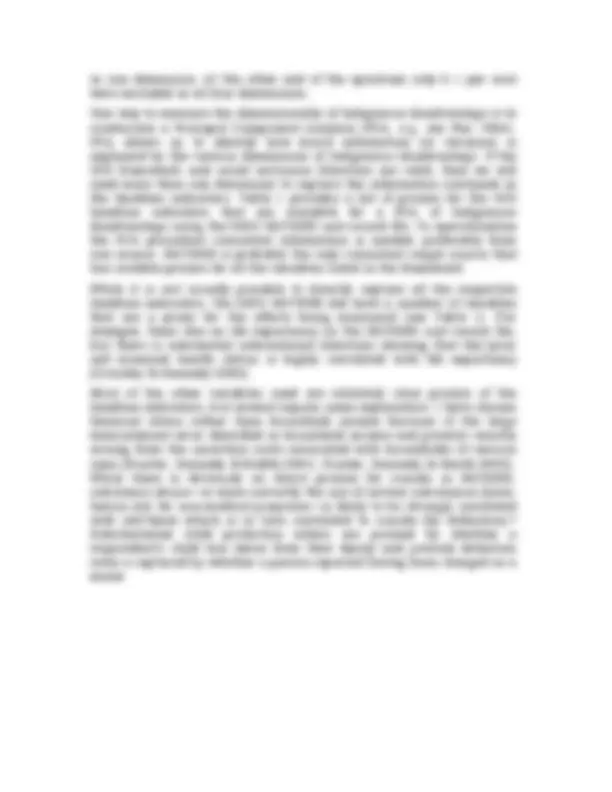
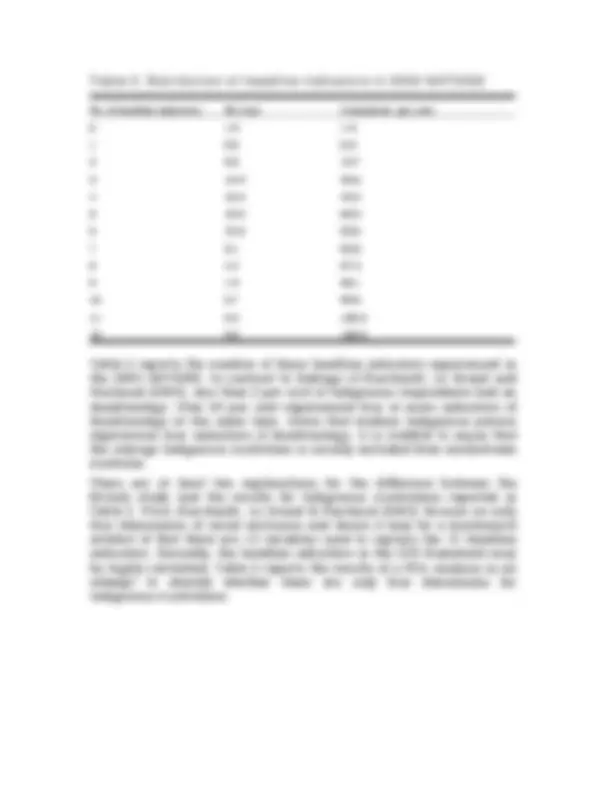
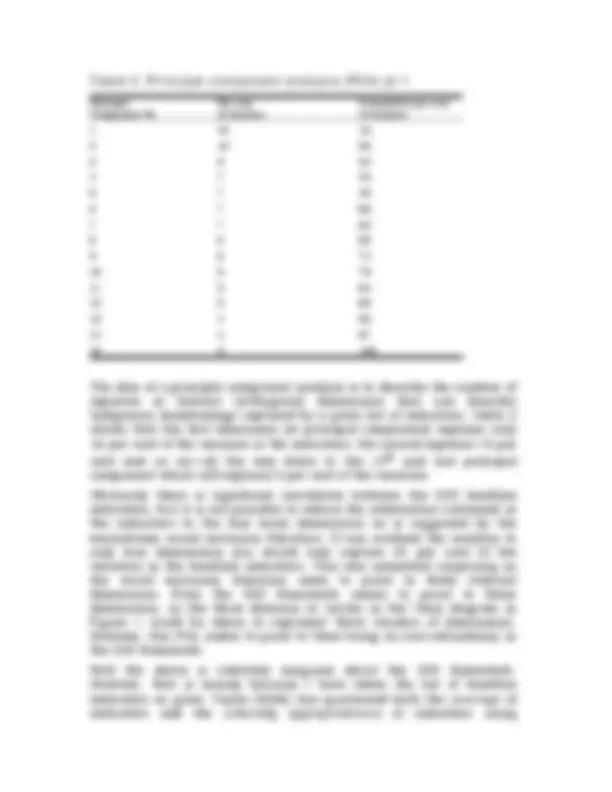
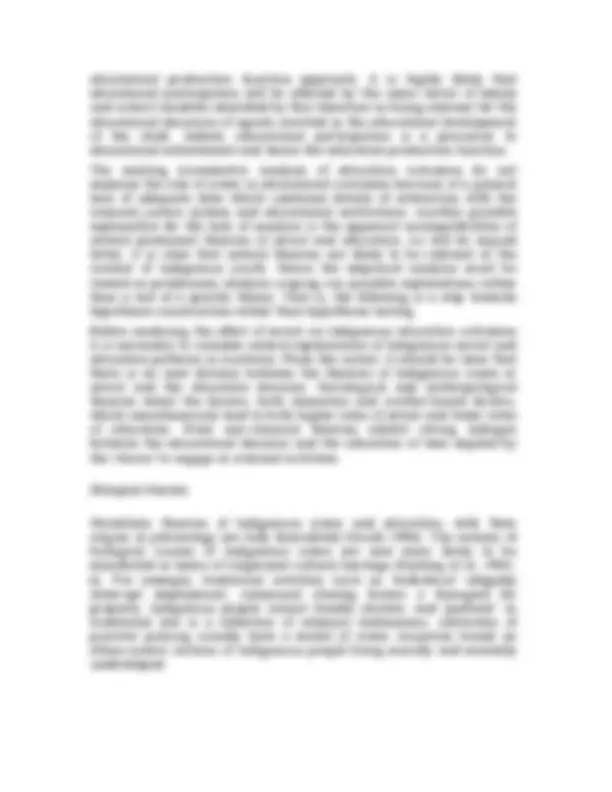
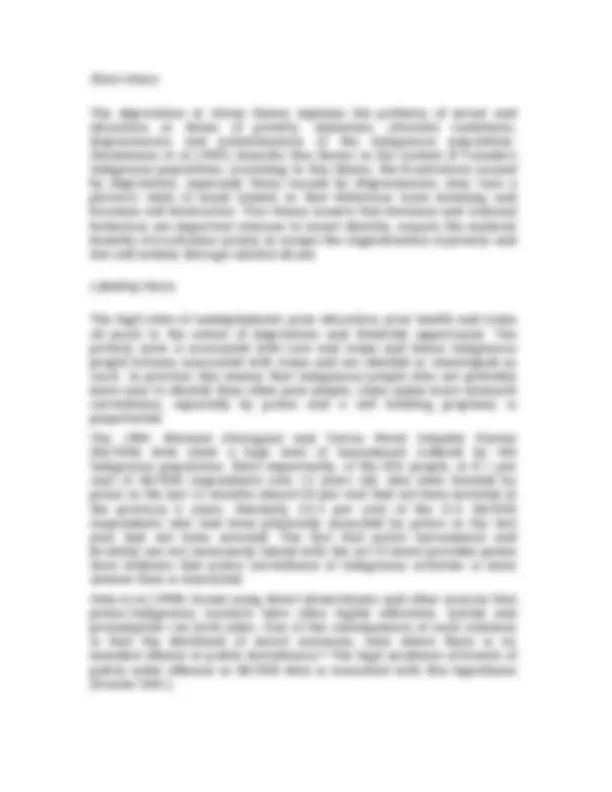

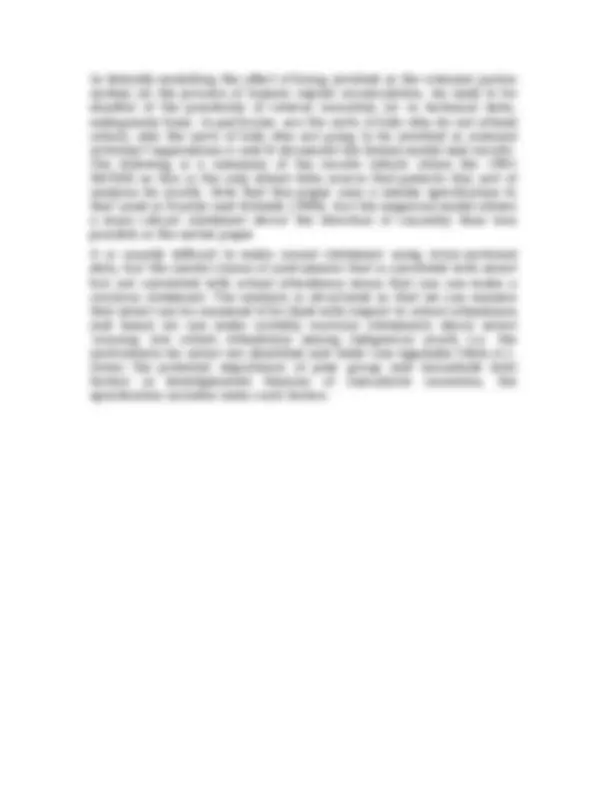
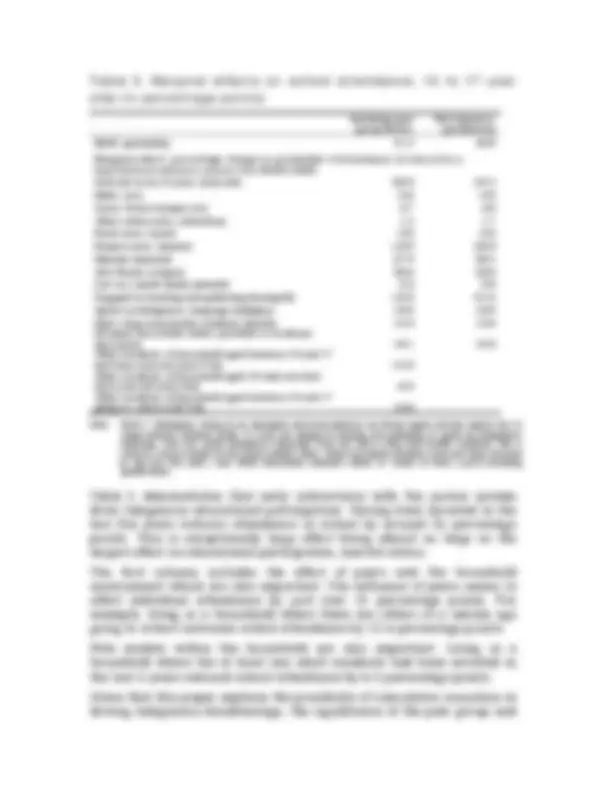
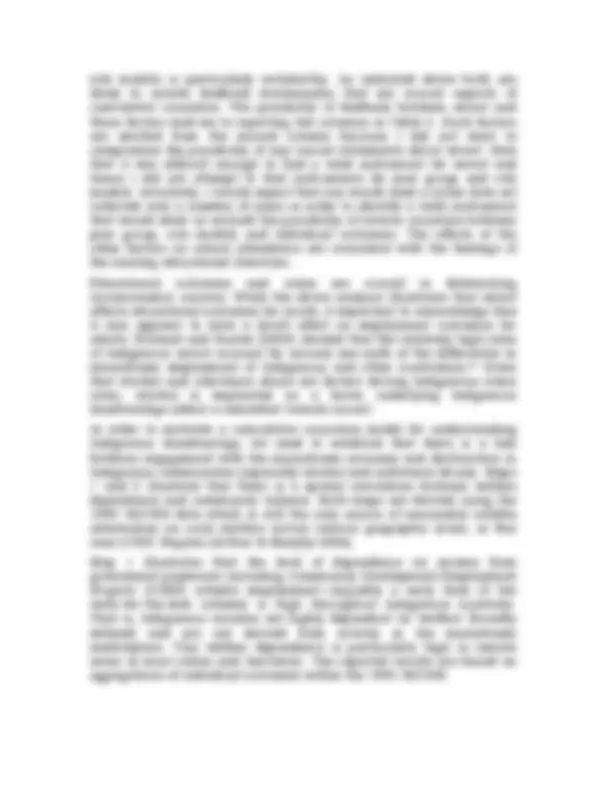
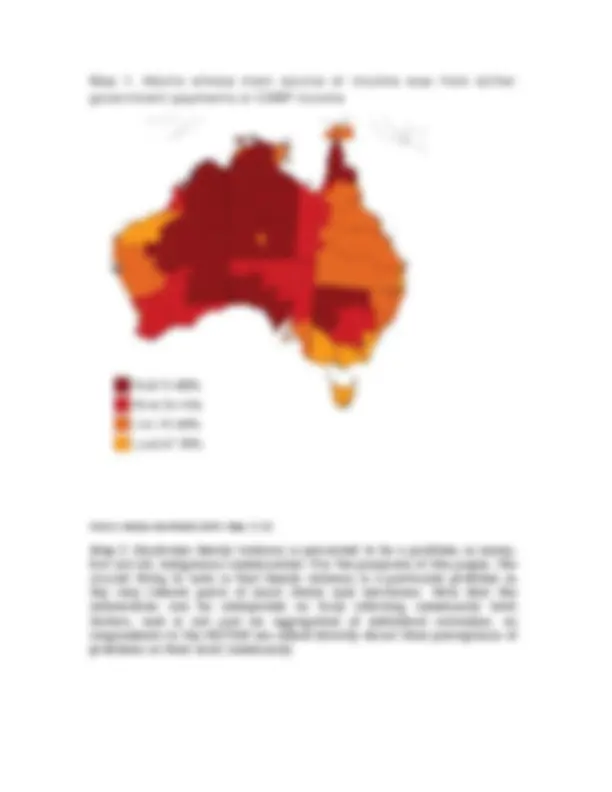
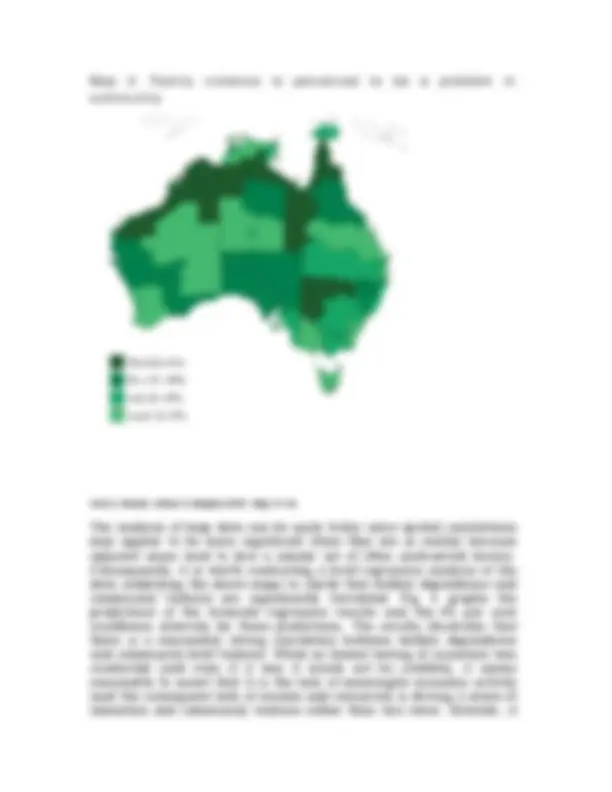
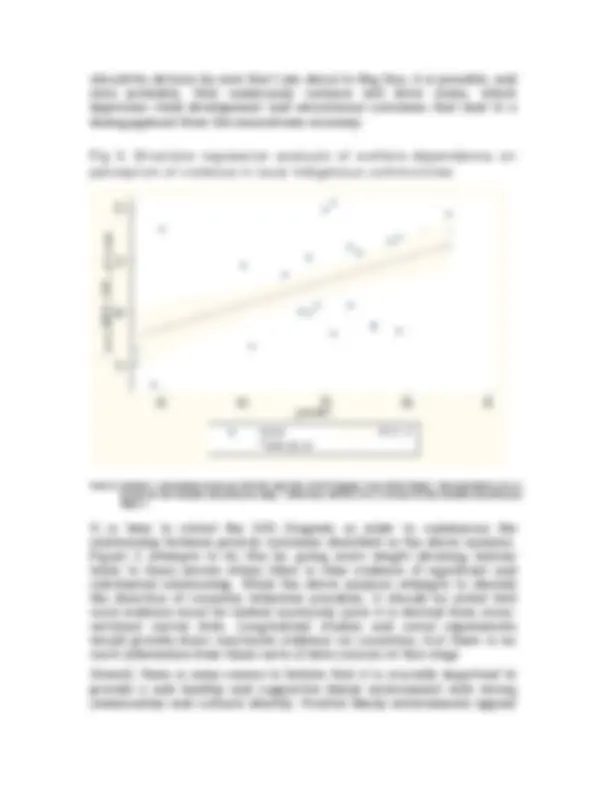
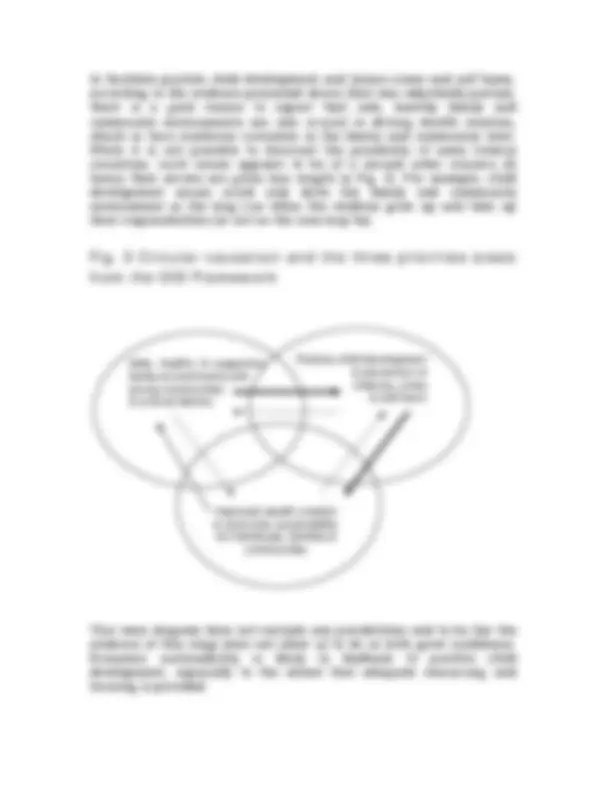
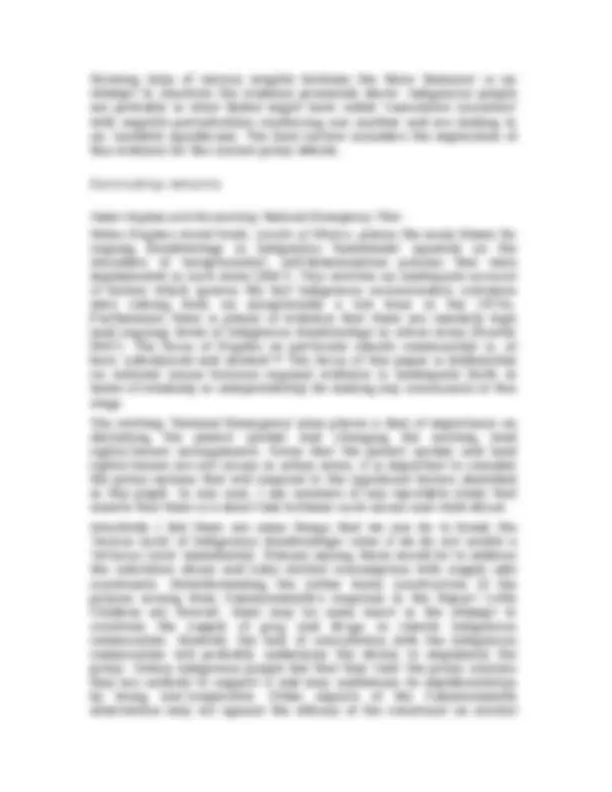
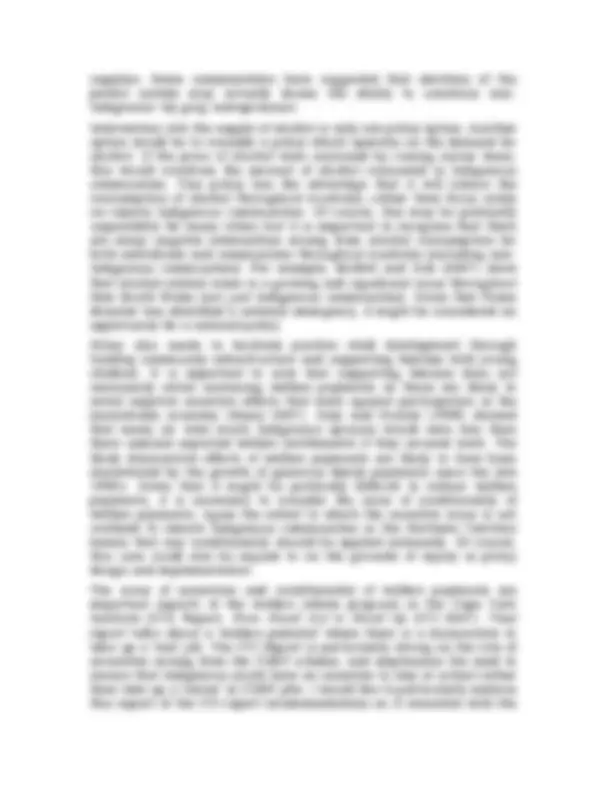
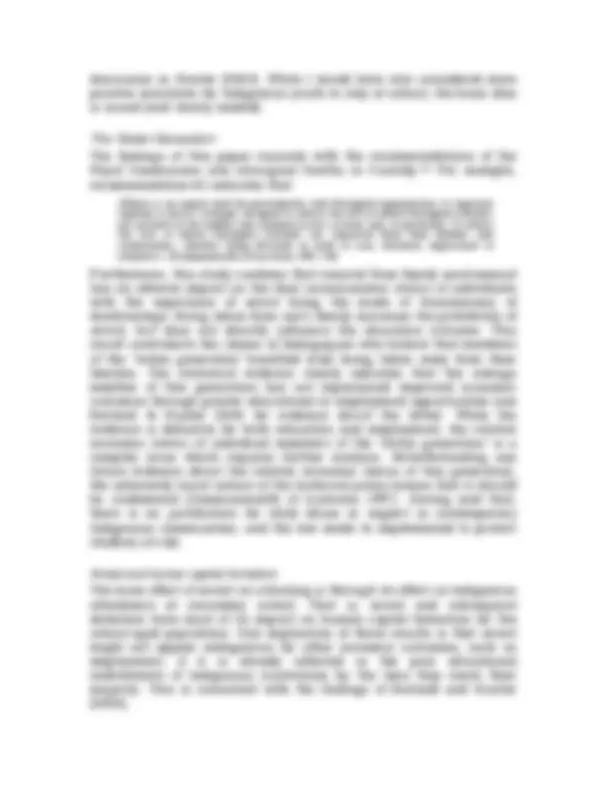
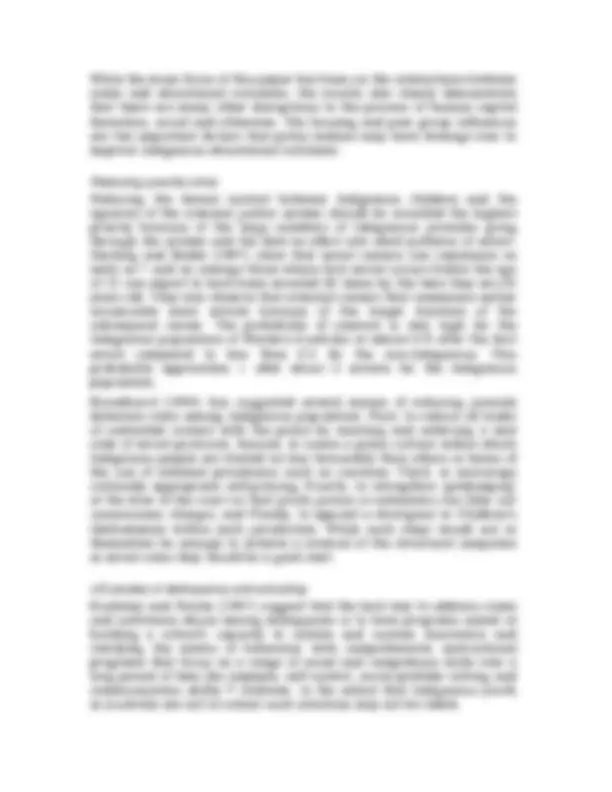
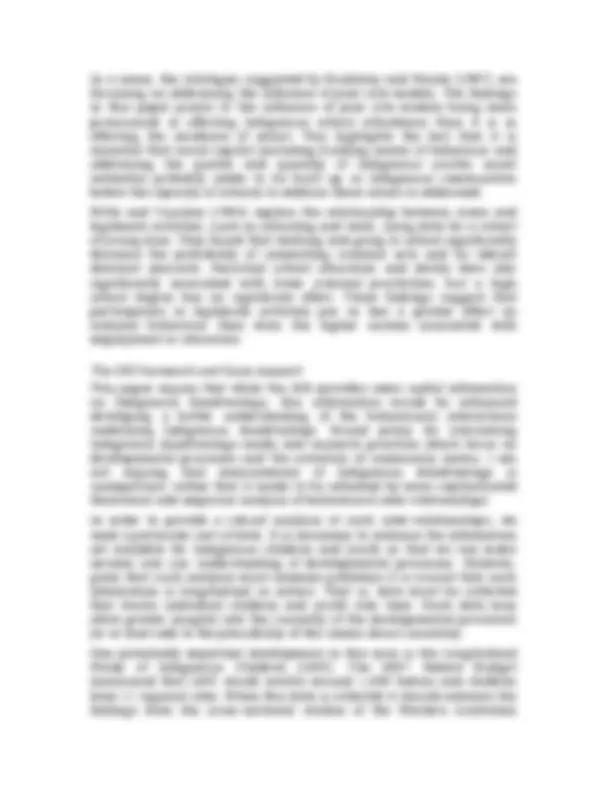
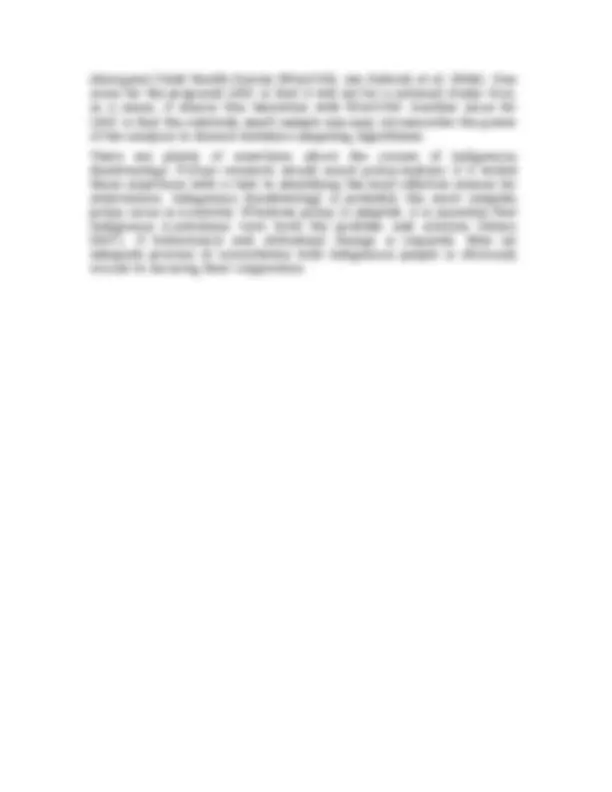
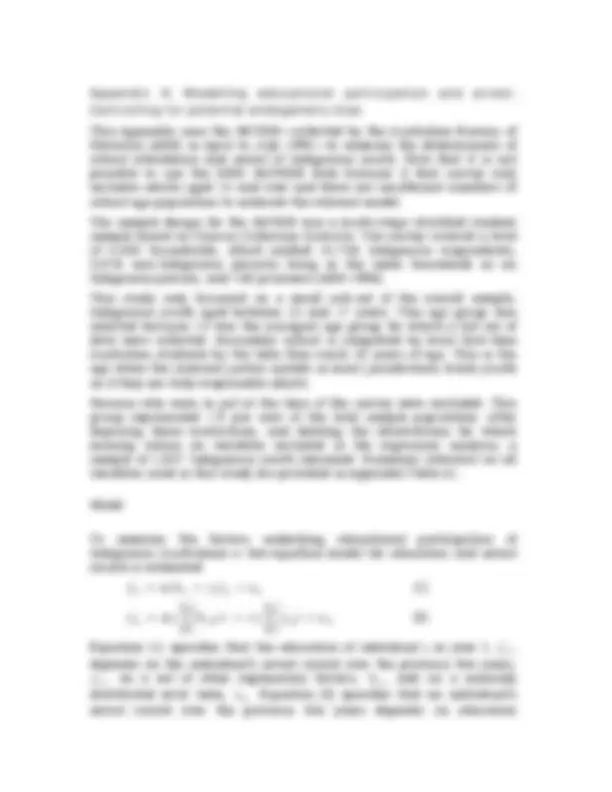
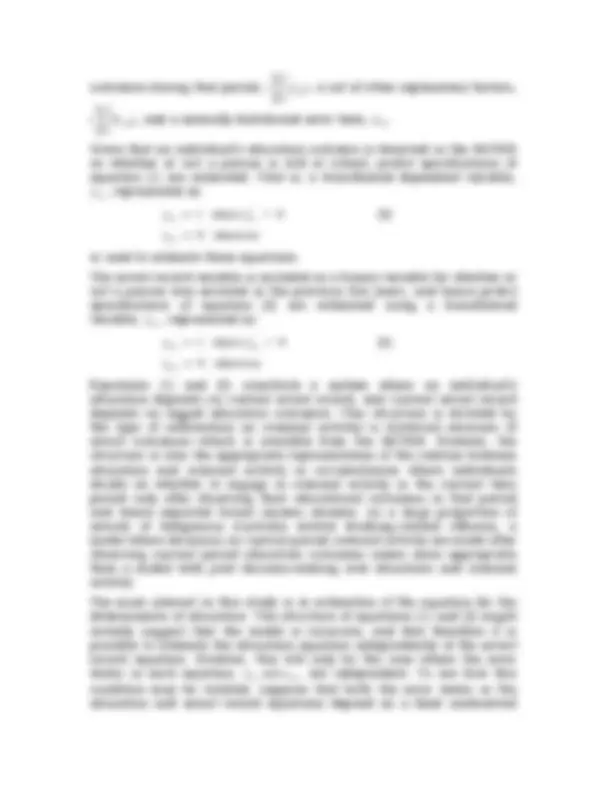
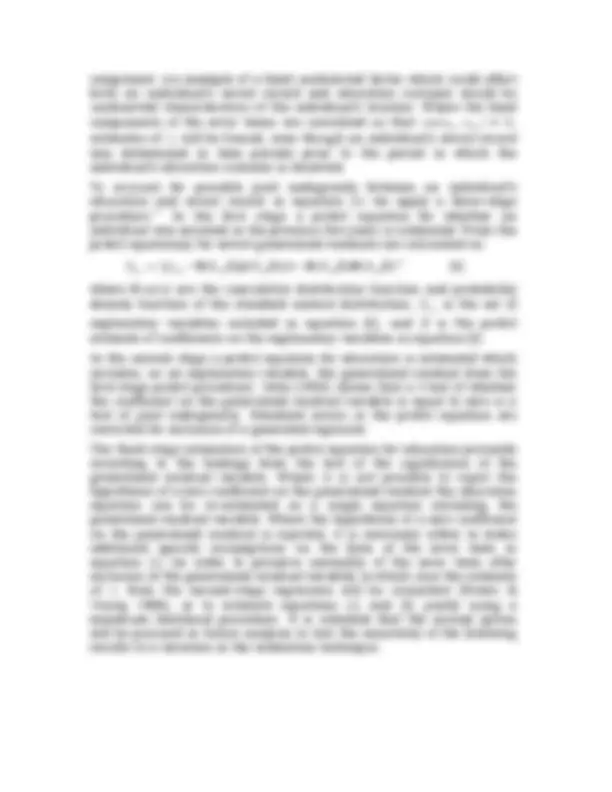
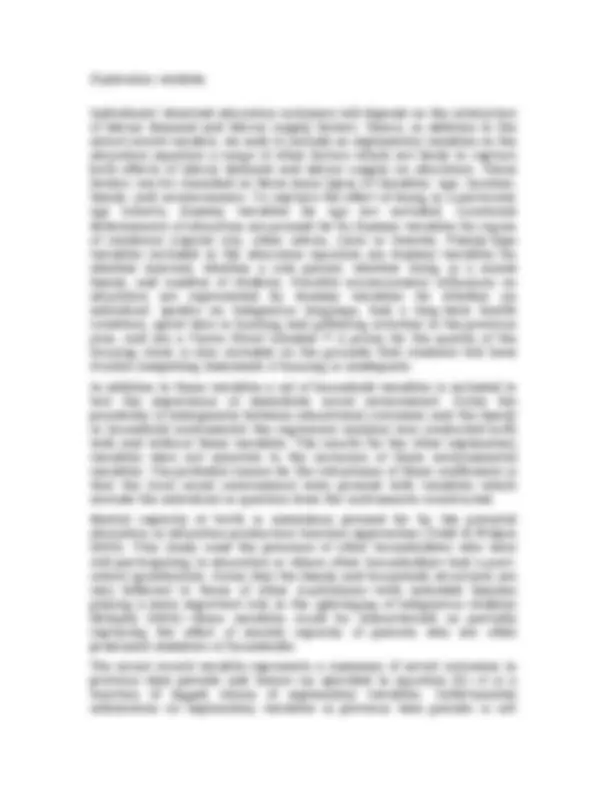
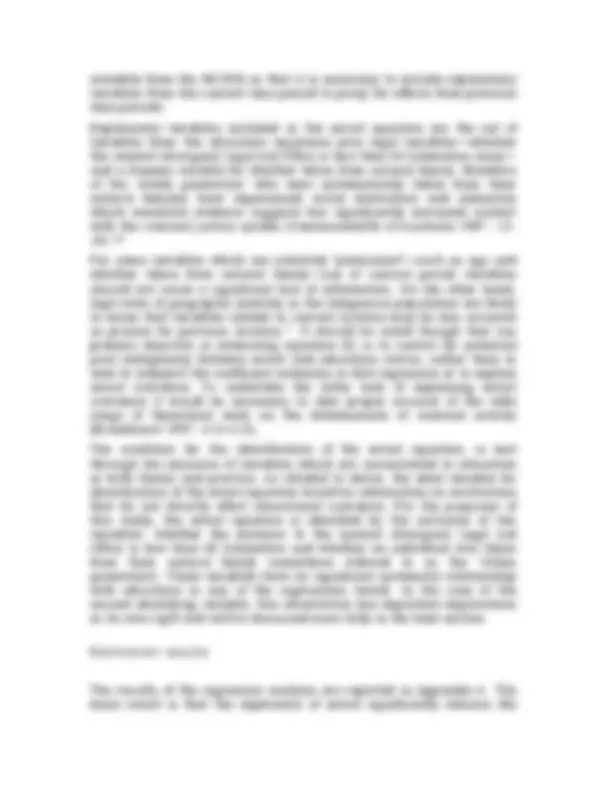
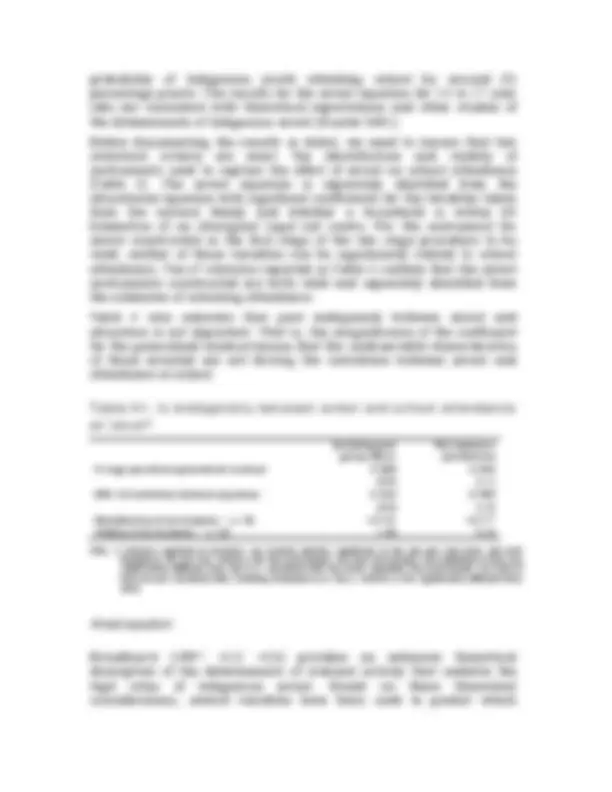
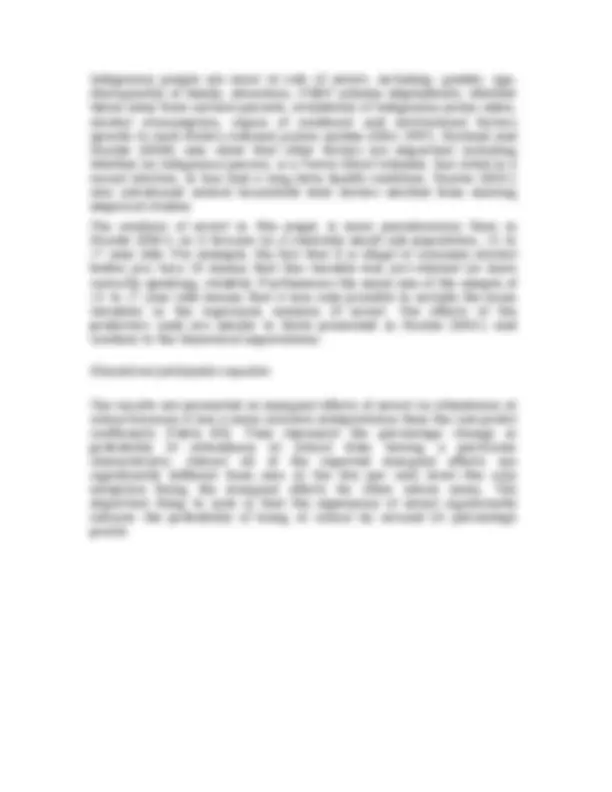
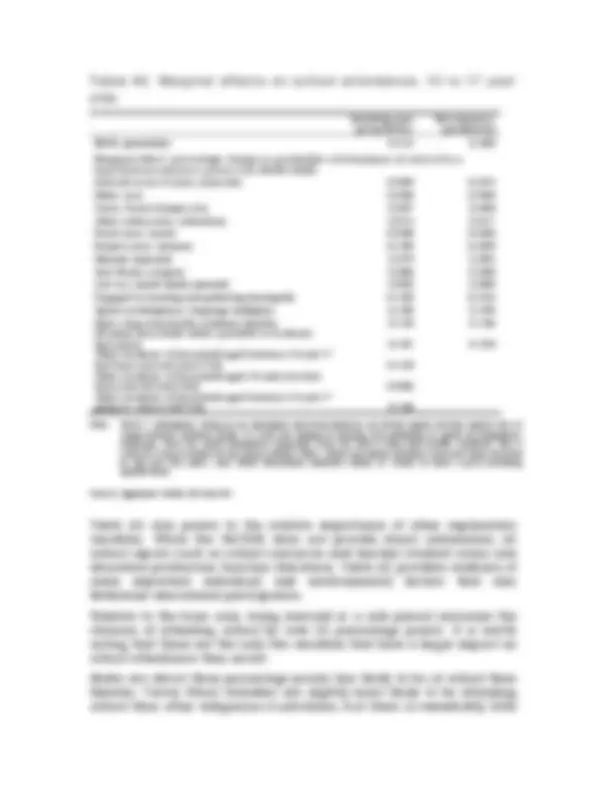
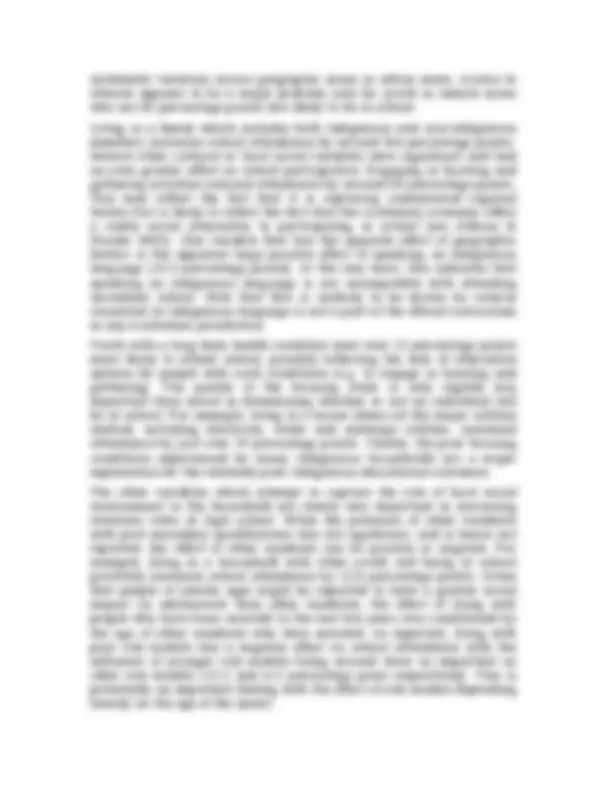
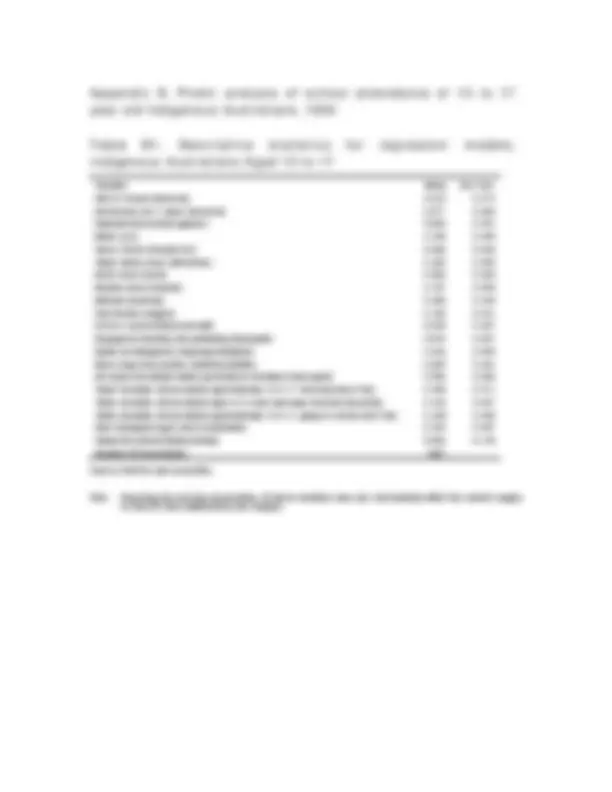
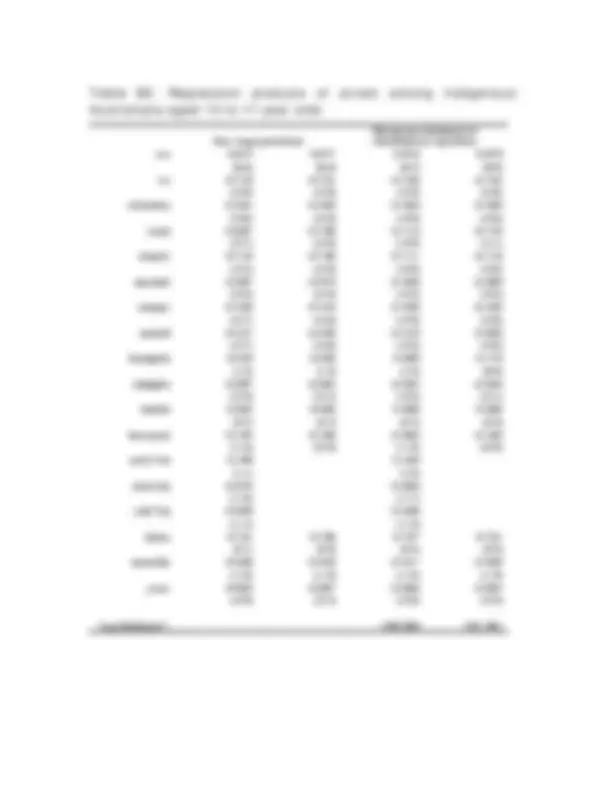
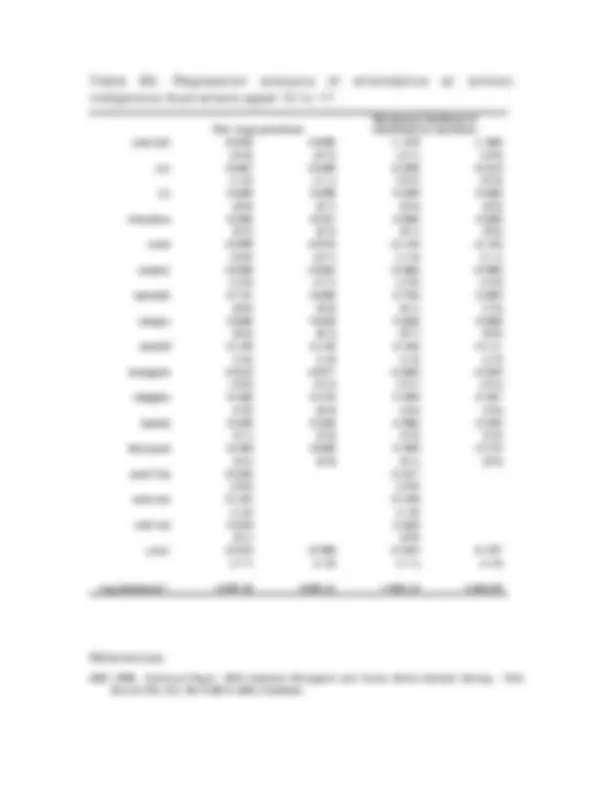
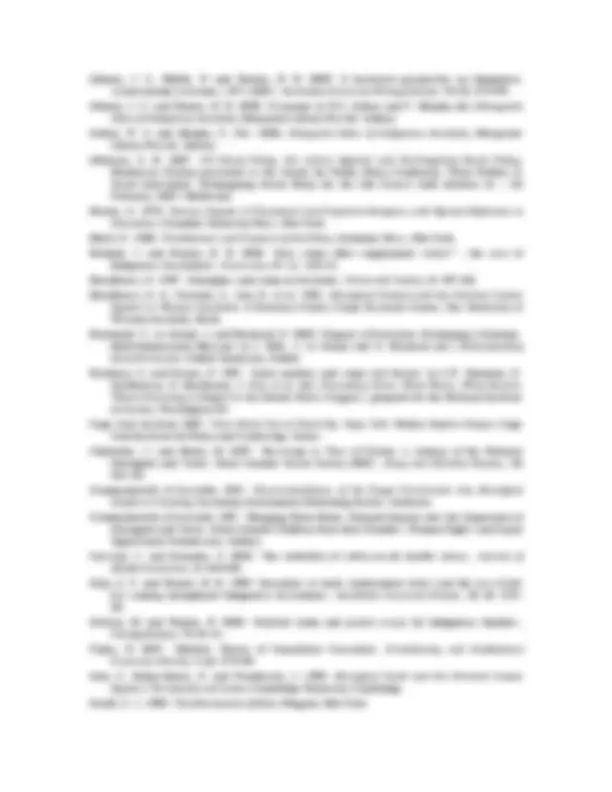
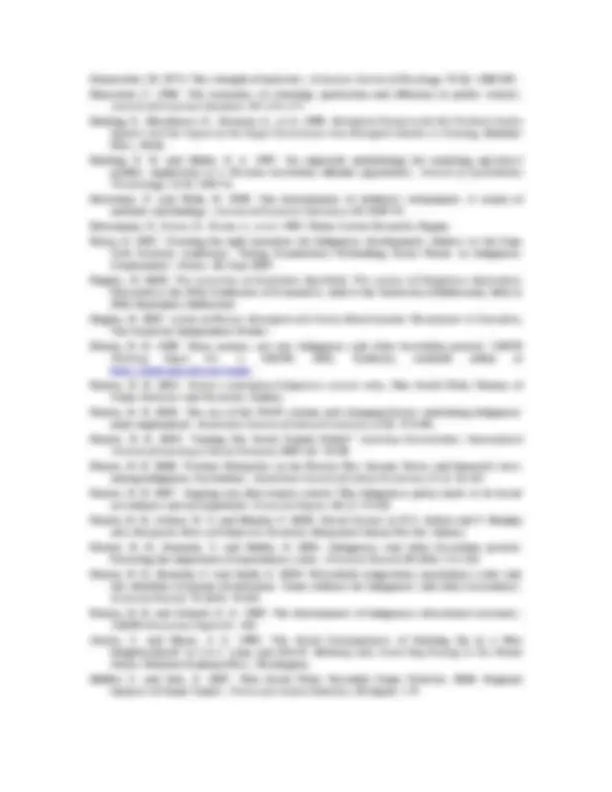
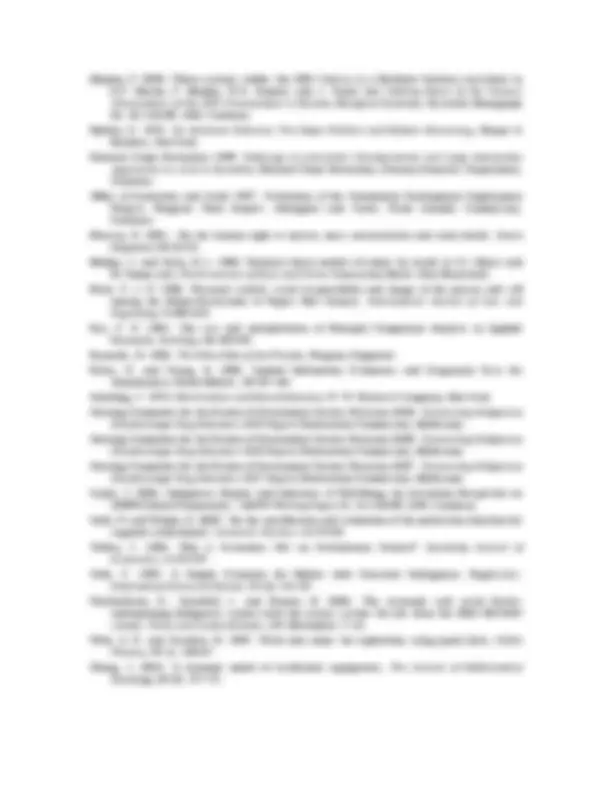
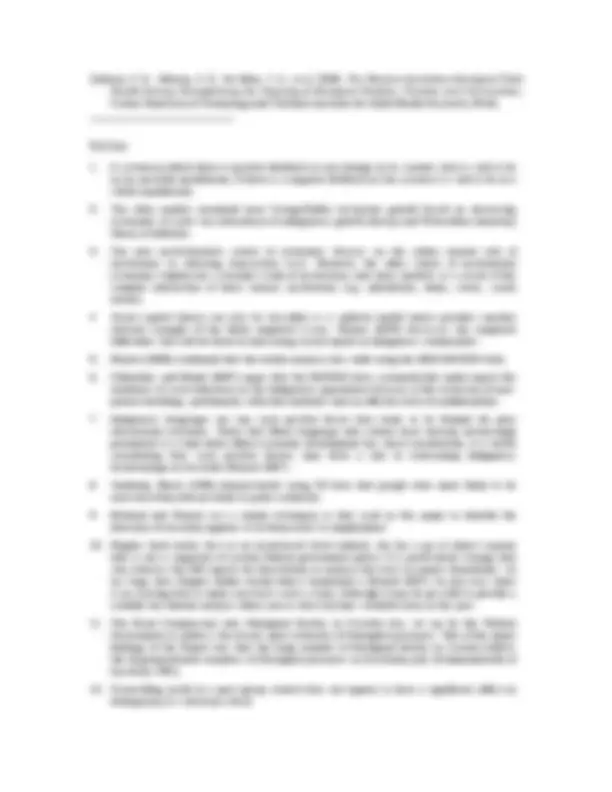



Study with the several resources on Docsity

Earn points by helping other students or get them with a premium plan


Prepare for your exams
Study with the several resources on Docsity

Earn points to download
Earn points by helping other students or get them with a premium plan
Community
Ask the community for help and clear up your study doubts
Discover the best universities in your country according to Docsity users
Free resources
Download our free guides on studying techniques, anxiety management strategies, and thesis advice from Docsity tutors
This paper explores recent evidence on Indigenous poverty and social exclusion in Australia, focusing on the relationship between Indigenous arrest and education outcomes. theories of Indigenous crime and education, the impact of arrest on school attendance, and the importance of addressing the root causes of Indigenous disadvantage. The paper also suggests ways to reduce juvenile crime and improve Indigenous educational participation.
What you will learn
Typology: Lecture notes
1 / 47

This page cannot be seen from the preview
Don't miss anything!








































Cumulative Causation and the Productivity Commission’s Framework for Overcoming Indigenous Disadvantage?
by
Boyd Hunter
Paper submitted for the Australian Social Policy Conference Social Policy through the Life Course: Building Community Capacity and Social Resilience, July 2007
Indigenous poverty is clearly entrench and often different in nature to that experienced by other Australian poor. This paper examines recent evidence on Indigenous poverty and social exclusion and attempts to relate it to the Productivity Commissions Framework for Overcoming Indigenous Disadvantage. However, it is not sufficient to measure the various aspects of disadvantage as we need to understand the pathways into disadvantage and the evolution of more sustainable positive outcomes. This is not a trivial exercise as it requires that theoretical models of the inter-relationships between these dimensions disadvantage be developed. The notion of cumulative causation, which had its origins in the writings of Thorstein Veblen and Gunnar Myrdal, may be a useful basis for building a model for overcoming Indigenous disadvantage. Note that the empirical tests of any such models are likely to informationally demanding and will probably require the collection of longitudinal data over the lifecycle. Notwithstanding such difficulties, this paper uses existing cross-sectional evidence to suggest circular causation between the three priority outcome areas identified by the Productivity Commission.
In recent years there have been many official responses to entrenched Indigenous poverty and disadvantage—principle among these is the Overcoming Indigenous Disadvantage (OID) framework (developed by the Productivity Commission), which is a product of the Council of Australian Government’s (COAG’s) response to the Reconciliation decade and the federal government’s focus on achieving greater statistical equality between Indigenous and other Australians in health housing education and employment, i.e. practical reconciliation. Biannual reports are produced by the Steering Committee for the Review of Government Service Provision (SCRCSSP) to evaluate statistics designed to evaluate progress in selected indicators (2003; 2005; 2007). These reports do not contain any policy recommendations merely focus on collecting and publishing better statistics on Indigenous disadvantage.
Before policy recommendations can be made, the evidence needs to be critically examined. However, evidence can only be interpreted using theoretical models. This paper discusses some models that involve the concept of ‘cumulative causation’ (i.e., where social processes go into an ongoing decline). One category of such models is the peer group theories which are examined in some details. Given that the OID framework seems to inform much of the current data collection, the following discussion reinterprets that framework in terms of the processes of cumulative causation. Empirical evidence is then provides to establish that cumulative causation is a plausible model by which policy decisions can be formulated and informed. The OID framework is also analysed, to confirm that it is informative and useful basis for data collection on Indigenous disadvantage (i.e. judged in its own terms).
The Federal Government has recently declared a ‘national emergency’ for remote Indigenous communities in the Northern Territory. How did this crisis happen? Indigenous disadvantage has not arisen suddenly— rather poor outcomes for Indigenous Australians appear to have cumulated over many generations. While the Howard government and its supporters rightly point to historical factors driving Indigenous disadvantage, their historical focus seems to be rather narrowly confined to the period between the early 1970s and the mid 1990s (e.g. Hughes 2005). The quality of the data was not really credible before 1981, but Census data seems to indicate that there has been steady although not spectacular improvements in certain socioeconomic outcomes since the 1970s (Altman, Biddle & Hunter 2005). Unfortunately, the respective census data do not provide an adequate source of information on individual wellbeing and community
In the context of Indigenous disadvantage the most relevant reference to cumulative causation is that by Nobel prize winning economist Gunnar Myrdal whose later writings were heavily influenced by Veblen’s brand of Institutional Economics.^3 Myrdal’s most influential and landmark book ‘An American Dilemma: The Negro Problem and Modern Democracy’, was originally published in 1944—dilemma referred to in the title is the co-existence of the American liberal ideals and the miserable situation of blacks
White prejudice and discrimination keep the Negro low in standards of living, health, education, manners and morals. This, in its turn, gives support to white prejudice. White prejudice and Negro standards thus mutually ‘cause’ each other.(Myrdal 1944)
Myrdal saw a vicious cycle in which whites oppressed blacks, and then pointed to blacks' poor performance as reason for the oppression. The way out of this cycle, he argued, was to either cure whites of prejudice or improve the circumstances of blacks, which would then disprove whites' preconceived notions. Myrdal called this process the ‘principle of cumulation’. Myrdal’s prediction that enhanced civil rights would break the vicious cycle proved hopelessly optimistic. Notwithstanding the rise of a visible black middle class in the US since the civil rights movement of the 1950s and 1960s, many Black Americans still experience relative socioeconomic disadvantage and economic segregation. For example, even though the Fair Housing Act of 1968 formerly banned racial discrimination, urban housing in America has been characterized by the persistence of racial segregation, the expansion and consolidation of black ghettos.
The reason for the ongoing economic segregation of racial groups can be illustrated using a game theoretic model of the housing market first developed by Schelling (1978). Zhang (2004) has formally shown that, without any discriminatory behaviour in the housing market, a slight racial preference for neighbours in one race can give rise to a high persistent level of residential segregation. Consequently, the elimination of discrimination may not be sufficient to achieve desegregation and improve the relative economic circumstances of Black Americans.
Even though a policy focus on racial discrimination may not necessarily produce the economic benefits anticipated by Myrdal, it is quite possible that there are other processes of cumulative causation that may be more amenable to possible policy intervention. One set of models that could be classified as involving cumulative causation are spillover models where outcomes for individuals or groups affects the same or related outcomes for other people.
Schelling's (1978) model can be classified a spillover model; as are network models of job search employment tends to be promoted through friends and social connections (e.g. Granovetter 1973). One spillover model, peer group theory is likely to be particularly important
in the context of Indigenous Australia as it seeks to explain how individuals’ norms and behaviours are shaped by the norms and behaviours of the people with whom they associate. Noel Pearson’s Cape York Institute recently ran a conference built on such themes, titled ‘Strong Foundations: Rebuilding Social Norms in Indigenous Communities’ (for details see http://www.cyi.org.au/).
There are two key features of spillover models: feedback effects and thresholds. As indicated above, feedback effects are also crucial aspects of social processes that involve cumulative causation. Thresholds are situations where behaviours change dramatically beyond a certain point.
Spillover effects are notoriously difficult to identify in empirical studies. For example, the extensive literature on ‘neighbourhood effects’ have remained inconclusive because of conceptual, measurement and statistical problems (Jencks & Mayer 1990).^4 Notwithstanding,^ the empirical difficulties that will be encountered in measuring spillover effects, as distinct from alternative explanations, many studies are consistent with such models. This paper presents direct evidence that is consistent with peer group models.
Indigenous poverty is clearly entrench and often different in nature to that experienced by other Australian poor. The conventional measures of disadvantage, such as Indigenous poverty are inadequate (Hunter 1999). Even the apparently financially secure Indigenous Australians suffer unconscionably high rates of morbidity, mortality, arrest etc. For example, 11 per cent of Indigenous residents in the top income decile were arrested in the previous 5 years. The incidence of being taken from one’s natural family is actually higher in the top income households. Clearly, income-based measures of Indigenous disadvantage are inadequate.^5
The OID framework organises Indigenous disadvantage into 3 categories of priority outcomes that includes 12 headline indicators and various strategic changes indicators. There is no neat concordance between the the three priority outcomes identified in Fig. 1 and headline indicators listed in Table 1.
Table 1. List of OID headline indicators and proxies in 2002
National Aboriginal and Torres Strait Islander Survey (NATSISS)
OID Headline indicato r Proxy used from 2002 NATSISS
Life expectancy
Self-assessed health status is ranked fair or poor
Rates of disability and/or core activity restriction (disability) Disability Status
Years 10 and 12 retention and attainment Years 10 and 12 retention and attainment
Post secondary education—participation and attainment Educational participation
Labour force participation or unemployment
Labour force participation or non-CDEP employment rates
Household and individual income
Financial stress: Unable to raise $2000 cash in an emergency
Home ownership Home ownership
Suicide and self-harm Non-medical substance use
Substantiated child protection notifications
Your children have been taken from their natural family
Deaths from homicide and hospitalisations for assault
Family violence is perceived to be a problem in the local neighbourhood or community
Victim rates for crime
Victim of physical or threatened violence in last 12 months
Given the multidimensional nature of the OID framework, it has a clear advantage over income-based measures of poverty. The framework could be described as an attempt to capture ‘social exclusion’. Social exclusion was developed in Europe because of the inadequacy of single dimension measures of disadvantage such as income poverty. Sir Tony Atkinson has recently described how the UK have substantially reduced child poverty through increased government spending directed and informed by a social exclusion model (Atkinson 2007).
An individual is socially excluded if he or she does not participate in key activities of the society in which he or she lives’ (Burchardt, Le Grand & Piachaud 2002). Participation is defined along four dimensions: Consumption (the capacity to purchase goods and services), Production (participation in economically or socially valuable activities), Political engagement (involvement in local or national decision-making), and social interaction (integration with family, friends and the community— sometimes called social capital).
Burchardt, Le Grand and Piachaud (2002: 35) measures the per cent of the working age population that is excluded along these dimensions using the British Household Panel Study. For example, 57.5 per cent were not excluded in any dimensions, but 30.1 per cent were excluded
in one dimension. At the other end of the spectrum only 0.1 per cent were excluded in all four dimensions.
One way to measure the dimensionality of Indigenous disadvantage is to conduction a Principal Component Analysis (PCA, e.g. see Rao 1964). PCA allows us to identify how much information (or variance) is explained by the various dimensions of Indigenous disadvantage. If the OID framework and social exclusion literature are valid, then we will need more than one dimension to capture the information contained in the headline indicators. Table 1 provides a list of proxies for the OID headline indicators that are available for a PCA of Indigenous disadvantage using the 2002 NATSISS unit record file. To operationalise the PCA procedure consistent information is needed, preferably from one source. NATSISS is probably the only consistent single source that has credible proxies for all the variables listed in the framework.
While it is not usually possible to directly capture all the respective headline indicators, the 2002 NATSISS did have a number of variables that are a proxy for the effects being measured (see Table 1). For example, there was no life expectancy on the NATSISS unit record file, but there is substantial international literature showing that fair/poor self assessed health status is highly correlated with life expectancy (Crossley & Kennedy 2002).
Most of the other variables used are relatively close proxies of the headline indicators, but several require some explanation. I have chosen financial stress rather than household income because of the large measurement error identified in household income and poverty—mostly arising from the uncertain costs associated with households of various sizes (Hunter, Kennedy & Biddle 2004; Hunter, Kennedy & Smith 2003). While there is obviously no direct proxies for suicide in NATSISS, substance abuse—or more correctly the use of certain substances (kava, heroin etc) for non-medical purposes—is likely to be strongly correlated with self-harm which is in turn correlated to suicide (by definition).^6 Substantiated child protection orders are proxied by whether a respondent’s child was taken from their family and juvenile detention rates a captured by whether a person reported having been charged as a minor.
Table 3. Principal component analysis (PCA) pt 1
Principal Component No.
Per cent of variance
Cumulative per cent of variance
1 16 16
2 10 26
3 9 34 4 7 42
5 7 49
6 7 56
7 7 62 8 6 68
9 6 74
10 5 79
11 5 84 12 5 89
13 4 93
14 4 97
15 3 100
The idea of a principle component analysis is to describe the number of separate or distinct (orthogonal) dimensions that can describe Indigenous disadvantage captured by a given list of indicators. Table 3 shows that the first dimension (or principal component) explains only 16 per cent of the variance in the indicators, the second explains 10 per
cent and so on—all the way down to the 15 th^ and last principal component which still explains 3 per cent of the variation.
Obviously there is significant correlation between the OID headline indicators, but it is not possible to reduce the information contained in the indicators to the four main dimensions as is suggested by the mainstream social exclusion literature. If one confined the analysis to only four dimensions you would only capture 42 per cent of the variation in the headline indicators. This was somewhat surprising as the social exclusion literature seem to point to fewer relevant dimensions. Even the OID framework seems to point to fewer dimensions, as the three domains or circles in the Venn diagram in Figure 1 could be taken to represent three clusters of dimensions. However, this PCA seems to point to there being no real redundancy in the OID framework.
Well the above is relatively sanguine about the OID framework. However, that is mainly because I have taken the list of headline indicators as given. Taylor (2006) has questioned both the coverage of indicators and the culturally appropriateness of indicators using
published UN perspectives on such frameworks. For example, the OID framework focuses on disadvantage, by definition, rather than attempting to measure a more holistic notion of well-being. That is, if one truly wants to overcome Indigenous disadvantage one might need to consider more positive aspects of wellbeing. The coverage of OID indicators is not complete and arguably asymmetric. Amongst other things the OID framework omits the size of the Indigenous estate, and economic value of subsistence activities—two examples of positive factors that will tend to ameliorate Indigenous disadvantage. Taylor provides a comprehensive list of relevant and culturally appropriate indicators that are not included in the OID framework.^7
If government reporting has little connection to Indigenous concerns and practice (i.e., fail to acknowledge the inter-cultural domain), then policy based on such frameworks can only expect to have limited success. This issue was indirectly raised by the Secretary of The Treasury, Dr Ken Henry in a speech to the aforementioned Cape York Institute conference held late last month:
To achieve progress in Indigenous development, there is a need for increased ownership, by Indigenous people, of both the problems and the policy solutions (Henry 2007).
Taylor (2006) also argues that there is an explicit causal model underlying the OID Framework. While there are clear notions about what constitutes Indigenous disadvantage within the OID framework, I do not agree with Taylor in that it incorporates a theoretical model that allows us to make sense of causal relationships and inform us about how the various dimensions of disadvantage relate to one another.
The remainder of this paper draws together some empirical analysis in order to suggest which behavioural relationships are important within the OID framework. Space constraints prevent a comprehensive ‘structural’ model of Indigenous disadvantage being developed in this paper, and hence the analysis is necessarily partial.
One criticism of the OID framework is that it merely provides systematic means of collecting data. To my mind this is a worthwhile objective in itself. As Ross Gittins argued in last week’s Sydney Morning Herald, if a phenomenon goes unmeasured it tends to get ignored.
Having said that one has to acknowledge the main inherent weakness of the OID framework, which is that it does not give policy makers a good sense of the inter-relation between various indicators. Should policy
educational production function approach, it is highly likely that educational participation will be affected by the same vector of family and school variables identified by this literature as being relevant for the educational decisions of agents involved in the educational development of the child. Indeed, educational participation is a precursor to educational achievement and hence the education production function.
The existing econometric analysis of education outcomes do not examine the role of crime in educational outcomes because of a general lack of adequate data which combines details of interaction with the criminal justice system and educational institutions. Another possible explanation for the lack of analysis is the apparent incompatibilities of several prominent theories of arrest and education. As will be argued latter, it is clear that several theories are likely to be relevant in the context of Indigenous youth. Hence the empirical analysis must be viewed as preliminary analysis scoping our possible explanations rather than a test of a specific theory. That is, the following is a step towards hypothesis construction rather than hypothesis testing.
Before analysing the effect of arrest on Indigenous education outcomes it is necessary to consider several explanations of Indigenous arrest and education patterns in Australia. From the outset, it should be clear that there is no neat division between the theories of Indigenous crime or arrest and the education decision. Sociological and anthropological theories detail the factors, both alienation and conflict-based factors, which simultaneously lead to both higher rates of arrest and lower rates of education. Even neo-classical theories exhibit strong linkages between the educational decision and the allocation of time implied by the ‘choice’ to engage in criminal activities.
Biological theories
Hereditary theories of Indigenous crime and education, with their origins in phrenology are fully discredited (Gould 1996). The notions of biological causes of Indigenous crime are now more likely to be manifested in terms of vulgarised cultural heritage (Harding et al. 1995: 6). For example, traditional activities such as ‘walkabout’ allegedly interrupt employment, communal sharing fosters a disregard for property, Indigenous people cannot handle alcohol, and ‘payback’ in traditional law is a reflection of inherent lawlessness. Advocates of punitive policing usually have a model of crime causation based on ethno-centric notions of Indigenous people being morally and mentally undeveloped.
Strain theory
The deprivation or strain theory explains the patterns of arrest and education in terms of poverty, alienation, stressful conditions, dispossession and powerlessness of the Indigenous population. Havermann et al (1984) describe this theory in the context of Canada’s Indigenous population. According to this theory, the frustrations caused by deprivation, especially those caused by dispossession, may turn a person’s state of mind inward so that behaviour loses meaning and becomes self-destructive. This theory asserts that deviance and criminal behaviour are important avenues to assert identity, acquire the material benefits of Australian society or escape the stigmatisation of poverty and low self-esteem through alcohol abuse.
Labelling theory
The high rates of unemployment, poor education, poor health and crime all point to the extent of deprivation and thwarted opportunity. The poverty cycle is associated with race and crime and hence Indigenous people become associated with crime and are labelled or stereotyped as such. In practice this means that Indigenous people who are probably more easy to identify than other poor people, come under more intensive surveillance, especially by police and a self fulfilling prophecy is perpetuated.
The 1994 National Aboriginal and Torres Strait Islander Survey (NATSIS) data show a high level of harassment suffered by the Indigenous population. More importantly, of the 834 people, or 8.1 per cent of NATSIS respondents over 12 years old, who were hassled by police in the last 12 months almost 50 per cent had not been arrested in the previous 5 years. Similarly, 23.4 per cent of the 215 NATSIS respondents who had been physically assaulted by police in the last year had not been arrested. The fact that police harassment and brutality are not necessarily linked with the act of arrest provides prima facie evidence that police surveillance of Indigenous activities is more intense than is warranted.
Gale et al (1990) found using direct observations and other sources that police/Indigenous contacts were often highly affrontive, hostile and presumptive—on both sides. One of the consequences of such relations is that the likelihood of arrest increases, even where there is no manifest offence or public disturbance.^8 The high incidence of breach of public order offences in NATSIS data is consistent with this hypothesis (Hunter 2001).
The developmental theories of crime are more consistent with a theory of cumulative causation as both emphasise the importance of historical processes, dynamic pathways and feedback mechanisms (such as peer effects). Even if alcohol and substance abuse had its roots in ‘alienation’ and ‘conflict’, the developmental theories emphasise its role is perpetuating pathways that lead to crime and hence they could in some sense be considered causes of Indigenous crime.
The interactions between Indigenous crime and education
Don Weatherburn, Lucy Snowball and I looked at the factors underlying interaction with the criminal justice system, or more precisely being charged with an offence in the 2002 NATSISS (Weatherburn, Snowball & Hunter 2006). Table 4 illustrates the main result—that substance abuse and risky alcohol consumption stood head and shoulders over the standard explanations of crime such as economic factors and welfare dependency. Both variables more than doubled the probability of being charged for the median person. While we do not present a formal theoretical model it seems reasonable that substance and alcohol abuse are impairing individuals’ judgments and creating a destructive social environment conducive to negative interactions with the criminal justice system.
Table 4: Marginal effects of selected variables for ever being
charged , 2002 NATSISS
Variable
Marginal effect of change in variable (in percentage points) Substance abuse 12. High risk alcohol consumption 11. Year 12 completion -4. Welfare as principal income source 4. Unemployed 4. CDEP 1. Expected Probability for the Median Case 8.
Source Weatherburn, Snowball and Hunter (2006: 11)
To my mind that raises the question: should substance abuse be given a higher priority than the other indicators when devising policy? That is not to say that welfare reform, and engagement with the mainstream economy are not important issues, rather they are probably second order concerns in the short term. I will argue later in this paper that education and engagement with mainstream society are further back in the causal chain, which probably explains why the direct effect of such factors appears to be smaller. All the factors in Table 4 need to be addressed when considering for long run policy options.
Fig. 2 Inter-dependence of crime and education outcomes
0
Aged 8– years
Aged 15– years
Aged 18– years
Aged 20– years
Aged 25– years
Aged 35 years and over
Never Charged
Age first charged
Proportion of Indigenous adults who
completed Year 12
Females Males
Source Dodson and Hunter (2006: 30)
Figure 2 charts the rate of completion of Year 12 by this variable to illustrate the importance of interactions with the justice system in affecting future outcomes for Indigenous youth. The ‘whiskers’ indicate the 95 per cent confidence intervals for the respective estimates (i.e. the range over which 95% of estimates will lie in repeated samples).
Indigenous people who have never been charged with an offence are three times more likely to have completed education to Year 12 than those who were first charged before their 18th birthday (i.e. before their ‘majority’). There is less systematic variation for those who were charged after they reached their majority. While being charged at 35 years of age or older is also associated with relatively low rates of school completion (to Year 12), this is likely to reflect a cohort effect as it was relatively unusual for older Indigenous people (who by definition are aged over 35) to finish secondary school. Consequently, Figure 2 provides a clear indication that early involvement in the justice system is hindering the process of human capital accumulation (see Hunter and Schwab 1998).
Given that the effect of being charged is manifest for the substantial numbers of Indigenous people who were charged as young as 8 years old, there is obviously a need for a greater focus on the developmental environment within families.
Table 5. Marginal effects on school attendance, 13 to 17 year
olds (in percentage points)
Including peer group factors
Parsimonious specification BASE probability 41.4 48. Marginal effect- percentage change in probability of attendance at school for a hypothetical reference person (the BASE CASE) Arrested in last 5 years (arrested) -25.3 -24. Males (sex) -2.6 -2. Torres Strait Islander (tsi) 2.7 3. Other urban areas (othurban) 1.4 1. Rural areas (rural) -3.8 -3. Remote areas (remote) -18.9 -20. Married (married) 27.9 25. Sole Parent (solepar) 25.6 23. Live in a mixed family (mixedf) 5.2 5. Engaged in hunting and gathering (huntgath) -18.3 -21. Spoke an Indigenous language (indiglan) 18.5 18. Had a long term health condition (health) 12.3 12. All major household utilites provided at residence (housqual) 19.1 19. Other residents of household aged between 13 and 17 had been arrested (arre17oh) -12. Other residents of household aged 18 and over had been arrested (arrestoh) -6. Other residents of household aged between 13 and 17 going to school (stil17oh) 12.
Note: BASE = Aboriginal; Living in an aboriginal only household in an urban region outside capital city; Is single without children under 13; Does not engage in hunting and gathering or speak an Indigenous language; Does not speak Indigenous language; Does not have a long term health condition; Has a room in a house where all the major utilities work; Other household members have not been arrested in the last five years; and Other Household members either at school or have a post-schooling qualification.
Table 5 demonstrates that early interactions with the justice system drive Indigenous educational participation. Having been arrested in the last five years reduces attendance at school by around 25 percentage points. This is exceptionally large effect being almost as large as the largest effect on educational participation, marital status.
The first column includes the effect of peers and the household environment which are also important. The influence of peers seems to affect individual attendance by just over 10 percentage points. For example, living in a household where there are others of a similar age going to school increases school attendance by 12.6 percentage points.
Role models within the household are also important. Living in a household where the at least one adult residents had been arrested in the last 5 years reduced school attendance by 6.2 percentage points.
Given that this paper explores the possibility of cumulative causation in driving Indigenous disadvantage, the significance of the peer group and
role models is particularly noteworthy. As indicated above both are likely to involve feedback mechanisms that are crucial aspects of cumulative causation. The possibility of feedback between arrest and these factors lead me to reporting two columns in Table 5. Such factors are omitted from the second column because I did not want to compromise the possibility of any casual statements about arrest. Note that it was difficult enough to find a valid instrument for arrest and hence I did not attempt to find instruments for peer group and role models. Intuitively, I would expect that one would need a richer data set collected over a number of years in order to identify a valid instrument that would allow us exclude the possibility of reverse causation between peer group, role models and individual outcomes. The effects of the other factors on school attendance are consistent with the findings of the existing educational literature.
Educational outcomes and crime are crucial in determining socioeconomic success. While the above analysis illustrates that arrest effects educational outcomes for youth, it important to acknowledge that it also appears to have a direct effect on employment outcomes for adults. Borland and Hunter (2000) showed that the relatively high rates of Indigenous arrest account for around one-sixth of the differential in mainstream employment of Indigenous and other Australians.^9 Given that alcohol and substance abuse are factors driving Indigenous crime rates, alcohol is implicated as a factor underlying Indigenous disadvantage (albeit a somewhat ‘remote cause’).
In order to motivate a cumulative causation model for understanding Indigenous disadvantage, we need to establish that there is a link between engagement with the mainstream economy and dysfunction in Indigenous communities (especially alcohol and substance abuse). Maps 1 and 2 illustrate that there is a spatial correlation between welfare dependence and community violence. Both maps are derived using the 1994 NATSIS data which is still the only source of reasonably reliable information on such matters across various geographic areas, in this case ATSIC Regions (Arthur & Morphy 2006).
Map 1 illustrates that the level of dependence on income from government payments (including Community Development Employment Projects (CDEP) scheme employment—arguably a early form of the work-for-the-dole scheme) is high throughout Indigenous Australia. That is, Indigenous incomes are highly dependent on ‘welfare’ (broadly defined) and are not derived from activity in the mainstream marketplace. This welfare dependence is particularly high in remote areas in most states and territories. The reported results are based on aggregations of individual outcomes within the 1994 NATSIS.